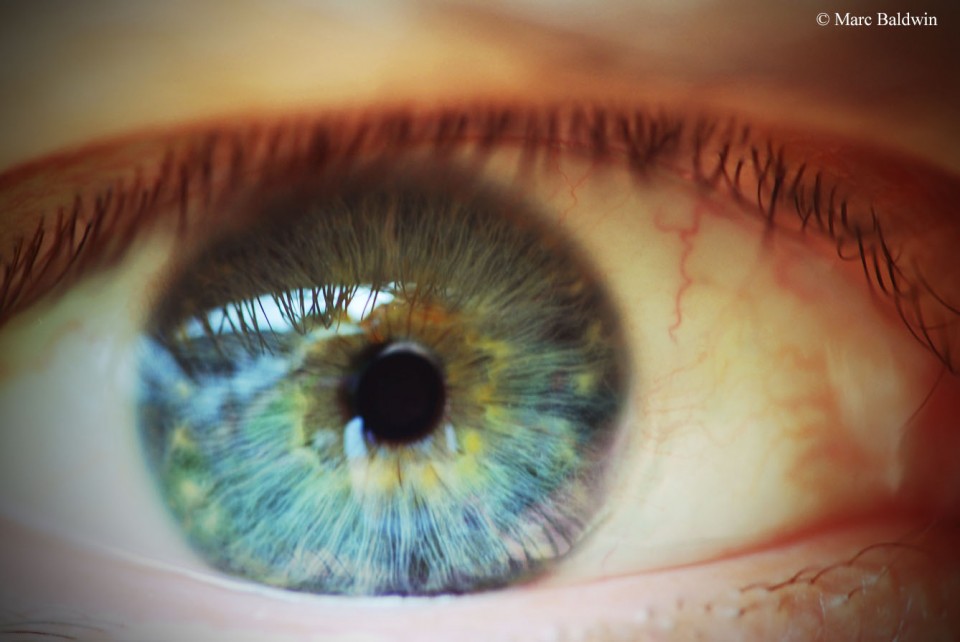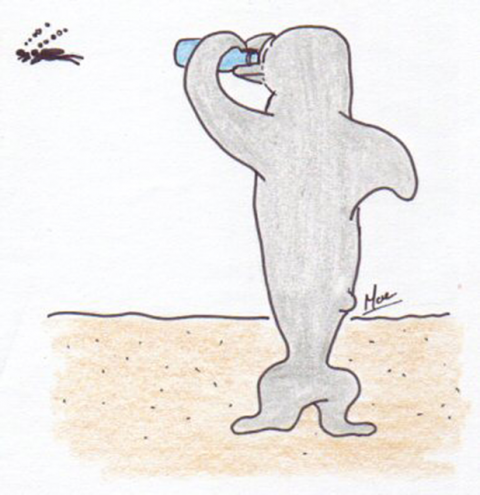Summary
Marine animals have several adaptations to their eyes, including different muscle arrangements, tissues of more similar density to the surrounding water and a more spherical lens than humans. The precise mechanism varies with species, however, with otters apparently relying more on muscles around the eye distorting the lens to focus, while whales have an eye so similar in density to seawater that very little focusing it necessary. Human eyes have evolved to bend light considerably to accommodate the much greater density of our eyes relative to the surrounding air – when underwater, this “over-bending” results in us being extremely long-sighted and everything looking blurred unless we add a layer of air in front of our eyes with the aid of goggles.
The details
Humans can see underwater, we just have difficulty focusing – hence objects appear blurred when viewed underwater without the aid of a scuba mask or goggles. Water is about 800 times denser than air and, as a result, light travels more slowly in it. Indeed, light travels almost 23% slower in water than it does in air, which represents a reduction in speed of approximately 66,000 kilometres per second (or about 41,000 miles per second).
The cornea of the human eye is also more dense than air and this causes light to be refracted (bent) as it passes through the pupil. This light is then ‘bent’ again by the lens to focus it onto the retina. Special ciliary muscles in the eye tighten and relax, distorting the shape of the lens to focus the image. When the light hits the rods and cones -- special light-sensitive cells on the retina -- they ‘fire’, sending messages to the brain via the optic nerve. Under ‘normal’ circumstances, light passes from a gas (air) into a liquid (the vitreous humour in the eyeball), but the situation is reversed underwater. The substantial difference in density between the water and the cornea causes the human eye to lose most of its refractive power; the lens is unable to compensate for this and the image appears out of focus.

The inability of our lens to accommodate this difference in refraction makes us acutely hyperopic, or long-sighted, underwater and objects appear blurred. Indeed, at distances more than five metres (about 16ft), humans are almost incapable of deciphering an object from the background underwater. Overcoming this problem requires a layer of air to be present in front of the eyeball (i.e. trapped by a scuba mask or goggles). This is not without its problems, though. If you imagine that our ray of light is happily travelling towards you at about 225,000 km per second (140,000 miles per second), suddenly it enters your scuba mask and accelerates to about 290,000 km per second (181,000 miles per second). This change of speed as the light passes from the water into the airspace of your mask causes its angle to shift slightly – this shift results in objects appearing about 25% bigger than they really are.
Fish obviously don't wear goggles, so how do they manage? Well, they have evolved to see things in the underwater world with the help of a larger, more spherical lens than land vertebrates. Additionally, there is very little difference in density between the fish cornea and that of the seawater, so there is very little refraction and focusing is left up to the lens. It is commonly considered that marine mammals can see equally well above and below the waterline. The mechanisms for this ‘dual-fluid’ vision are, however, largely speculative.

A study by Ronald Schusterman and Barry Barrett in 1973 revealed some interesting insights into the visual system of the Asian short-clawed otter (Aonyx cinerea). Schusterman and Barrett designed a series of experiments to test the otters’ visual acuity (i.e. how well the otters could decipher fine detail) in air and underwater at different light levels. They found that the otters had almost equal visual acuity in water and air under conditions of bright light, but their underwater vision was poorer than their vision in air under conditions of dim light. Schusterman and Barrett considered that otters probably have a similar focusing mechanism to turtles, in that the front of the lens is squeezed by muscles around the iris. Hence, they suggest that poor underwater vision in the dark might be a result of pupil dilation leading to an insufficient squeezing of the lens. In terms of optical morphology, the otter uses a similar method of maintaining visual acuity as fish (i.e. the lens is more spherical so that it can compensate for the different refractive index of water).
In whales, the difference in refractive index between the cornea and seawater is slight, much less than it is in humans, so there is little focusing taking place at the water-cornea interface. Some evidence also indicates that many whales lack interocular (between eyes) muscles, suggesting that focusing is either less important or accomplished differently. Dolphins apparently have eyes more similar to fish than humans – the lens is greatly increased, almost spherical in shape and situated further forward in the eye. According to chairman of the Information Committee of the European Association for Aquatic Mammals, Jaap van der Toorn, the dolphin retina is “organized differently than most mammal eyes”, having two yellow spots. Yellow spots, also known as foveas, are areas of high sensitivity and the human eye only has one. van der Toorn suggests that one spot is probably associated with forward vision, the other with lateral vision.
Interestingly, a similar structure was observed on the retina of the great white shark (Carcharodon carcharias) by Samuel Gruber and Joel Cohen in their 1985 paper; it's thought that it may increase the sharks’ visual acuity in poor light conditions, especially at dawn and dusk. van der Toorn also notes that the dolphin pupil has a covering that can slide over it in conditions of bright light, possibly giving the dolphin a greater depth-of-field above water.
A paper to the journal Cetology during 1972 reported that dolphins are myopic, or short sighted, in air. In the paper, William Dawson and his colleagues suggest that the aerial acuity in bottlenose dolphins (Tursiops truncatus) may be equal to their underwater acuity because they have a pupil that becomes tightly constricted in bright light (i.e. in air) compared to water. Several studies on dolphin vision have suggested that in water (and possibly air) dolphins were emmetropic (i.e. focused at infinity).

In an intriguing paper published in the journal Marine Mammal Science back in 2001, Thomas Cronin and Tricia Litwiler attempted to identify the mechanism by which dolphin eyes were able to adjust to focus on objects at various distances. Their measurements of the refractive state of the dolphin’s eyes in water revealed that two individuals were indeed emmertrophic, while a third was slightly myopic. Interestingly, Cronin and Litwiler found no evidence for accommodation in any of the subjects examined. The authors propose that underwater vision may be used merely to supplement echolocation and, as such, the ability to focus sharply may not be necessary.
A study looking at pinnipeds (seals and sea lions) found a similar response to that described by Schusterman and Barrett in otters. In his 1970 paper to the journal Science, Ronald Schusterman found that, in the Californian sea lion (Zalophus californianus), only when luminance levels were reasonably high (in the range of 100 to 200 mL) were the sea lions able to resolve detail equally well in air and underwater.
In conclusion, it seems that there has been a degree of convergent evolution of the eye in marine species, leading to a scenario where the lens is larger and more spherical in shape to compensate for the loss of corneal focusing input. It is often difficult for us, a species for whom vision is such a crucial sense, to comprehend how animals could perform in a blurry world. When you watch aquatic predators hunting, however, it becomes apparent that the ability to focus a pin-sharp image is much less important to them than it is to us - otters feel for their prey, dolphins echolocate, whale sharks may ‘sniff out’ microscopic plankton, and so forth.